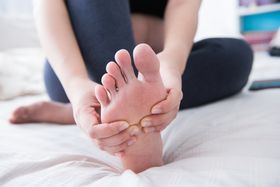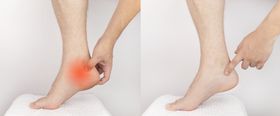Pickleball and Plantar Fasciitis: Managing Discomfort on the Court
Follow our expert advice on how to relieve pain and discomfort caused by Plantar Fasciitis to stay in top form on the pickleball court.
Updated July 16, 2025

Do you find yourself wondering why your heel hurts after playing pickleball? Among the many related problems players encounter, Plantar Fasciitis is among the most common.
This condition can significantly hinder your mobility, stamina, and overall performance as you navigate the court, ultimately making the game less enjoyable. So, let's look at ways to manage it effectively, alleviate discomfort, and empower you to perform at your best.
What Is Plantar Fasciitis?
Plantar Fasciitis is an inflammation of the plantar fascia, a thick band of tissue that runs across the bottom of your foot and connects your heel bone to your toes. It is one of the most common causes of heel pain, especially among athletes and individuals who put strain on their feet.
How Does Pickleball Cause Plantar Fasciitis?
Pickleball involves quick changes in direction, repetitive starts and stops, and explosive movements. Over time, these motions cause microtrauma to the plantar fascia. It then results in immense pressure on the foot, causing inflammation and stabbing heel pain.
Another reason is the overstretching of the plantar fascia when jumping for smashes or lunging for drop shots, especially if you don't warm up.
» Discover ways to relieve your foot pain using pressure points
Ways to Treat Plantar Fasciitis
When it comes to treatment options, your approach should be tailored to the timeline of the game. There are things you can do beforehand, during the match, and afterward to alleviate discomfort.
1. Choose Proper Footwear
Footwear and custom insoles like the ones from Upstep are essential for pickleball players. Proper shoes with good arch support can help absorb the impact of the explosive actions involved in the pickleball game. They can improve stability and control and minimize the pain. You should also avoid wear and tear with existing shoes as this can worsen your condition.
2. Elevate Your Game Prep
Taking the time to warm up properly before the game can reduce the chance of a flare-up while playing. Stretching and strengthening exercises can increase flexibility and fast-track your recovery.
A Kinesio tape can ease tension on the plantar fascia and relieve the pain. It can also improve circulation, which may reduce inflammation.
Note: Maintaining a healthy weight and staying hydrated is also essential for preventing Plantar Fasciitis.
» Check out these exercises you can do to manage Plantar Fasciitis
3. Modify Your Playing Style
You may need to modify your play style during the game to avoid explosive motions and lunges. Opt for doubles and shorter rallies to prevent worsening the pain. If you feel it's intensifying, take a break and ice your foot on the sidelines.
Make sure to stretch again and cool down after the game. You can also opt for an over-the-counter medication to deal with the pain post-match.
Playing Towards Peak Performance
Alleviating heel pain from Plantar Fasciitis is crucial for pickleball players to maintain peak performance. By integrating several lifestyle changes and following our advice on managing your injury, you can prevent its occurrence and recurrence.
Additionally, high-quality custom insoles like Upstep can provide essential stability and support, further enhancing foot health and reducing heel pain after pickleball. Stay proactive in addressing these issues to enjoy a pain-free experience on the court.








